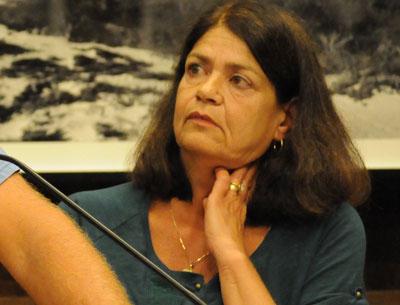New House Okayed for 9-Acre Lot
New House Okayed for 9-Acre Lot

Adelaide de Menil, who donated the historic buildings that now form the new Town Hall complex to East Hampton Town, received approval from the town’s zoning board of appeals Tuesday to build a new house for herself on Mile Hill Road in East Hampton overlooking Northwest Harbor.
According to Laurie Wiltshire of Land Planning Services, the 8,400-square-foot, four-bedroom house will sit on a parcel of land slightly larger than nine acres. The plans include a 1,112-square-foot attached garage and gardener’s shed with a bath, a 600-square-foot barn, a 600-square-foot pool, a generator, and a new septic system on the site. The two residences that formerly stood there have been removed.
Ms. Wiltshire appeared before the East Hampton Town Zoning Board of Appeals on Sept. 18 on behalf of Ms. De Menil. “We did a lot of research,” Ms. Wiltshire said Monday. Two years into the project, Ms. Wiltshire’s team has achieved the goals laid out for them by Ms. de Menil: “It is designed to be as conforming as possible to all elements of the code,” Ms. Wiltshire said, while having minimal impact on the environment.
It will be a “green” house, with solar panels on the roof, and will not be visible from any neighboring properties. The project includes a revegetation plan to cover nearly an acre of previously cleared land with native growth.
The only variance the project needed from the zoning board was for the septic system, because it is in a Harbor Protection Overlay district, and the proposed septic system would be 153 feet from the surrounding wetlands when 200 feet is normally required.
“There is no location where the septic system could be placed without needing a variance,” Ms. Wiltshire told the board on Sept. 18.
The board received one letter from a neighbor on Powder Hill Lane asking the builders to consider a different septic system. However, Alex Walter, the board’s chairman, noted that the system suggested by the neighbor would actually be bigger than what Ms. Wiltshire proposed.
There was little debate about the proposal, and much praise from board members.
“It’s a huge piece of property and they’re only developing a small piece,” said Sharon McCobb, before the board voted unanimously Tuesday night to approve the project, which needs additional permits from the State Department of Environmental Conservation and the County Health Department.
Ms. Wiltshire will appear before the board again on Tuesday on behalf of Jerry Seinfeld, who is installing state-of-the art solar panels, making his Further Lane estate energy self-sufficient.
There were two other variance requests voted on by the board Tuesday, both of which drew members’ criticism earlier. In both cases, work was done without receiving prior approval, putting the board in a position where it was being asked to approve a project retroactively. As with the de Menil application, both of the original public hearings were held on Sept. 18.
Mary Schoenlein, owner of Mary’s Marvelous on Main Street in Amagansett, had already appeared before the town’s planning board earlier this year in her efforts to get approval for a new walk-in refrigerator behind her restaurant. The planning board, in its preliminary discussions, was very supportive, but told Ms. Schoenlein she would have to get approval from the zoning board for a 20-by-20-foot concrete slab for the refrigeration unit to sit on.
“Months are going by and my season was approaching and I began to get worried,” Ms. Schoenlein said at the Sept. 18 hearing, explaining why she built the walk-in without receiving final approval. “A series of things happened and I made a mistake. I misjudged the situation,” she said.
“What we have again is another retroactive request although this may have been an honest mistake,” said Don Cirillo, a board member, before the board voted unanimously to approve the application.
A second project that went ahead without the needed variances was that of Stanley and Marie Einzig of 38 Shipwreck Lane in Amagansett, who built a 1,400-square-foot brick patio as well as a 180-square-foot pergola without getting the needed variances from the board.
“When you come out of the sliding doors you are 8 to 10 feet from the pool. The pergola provides the only shade,” said Martha Reichert of LandMarks, in explaining to the board on Sept. 18 why the work was done without the proper approval. She added that a prime factor motivating the Einzigs was the safety of their grandchildren, noting that a grandchild had fallen into the pool before the work was done, and that the patio made the yard safer.
“It’s always frustrating when people do these projects without [first getting approval]. It seems to be happening a lot lately,” Ms. McCobb said.
“It looks like a deliberate request to abuse the system,” said Mr. Cirillo.
In the end, the board approved an amended variance request, 4-1, that permitted the Einzigs to keep their patio and pergola, but requires them to remove a 10-foot wide strip of brick patio from the eastern side of the property. Lee White, voting in dissent, thought the board should also have required a scenic easement.



